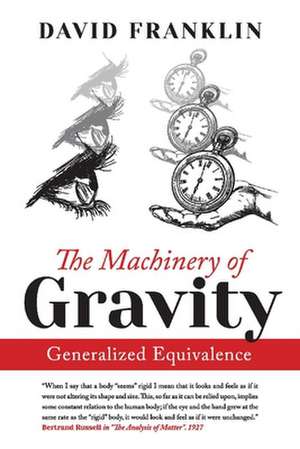The Machinery of Gravity: Generalized Equivalence
Autor David Franklinen Limba Engleză Paperback – 30 iul 2021
Main theme of book is that the machinery of gravity is all matter is accelerating forever. The book explores this idea, shows it is a feasible interpretation of facts, explains why this is true, applies the teachings to six problems in physics finding simpler solutions for them, and solutions for several where none are at present are known. The six are: (1) Bending of starlight; (2) Advance of Mercuries perihelion; (3) Explanation for behavior of spiral galaxies, (4) Expansion of earth, (5) Anomalous acceleration terms of Pioneer 10 and 11, (6) Accelerated expansion of universe.
The book starts by citing Einstein's metaphor of observer in accelerated chest unable to distinguish that state with his being at rest on the earth. This was his Principle of Equivalence that started his development of his gravity theory (General Relativity). Obvious/intuitive rejection of this idea is that Newton's gravity law cannot be violated and it would seem (for example) that if I had two spheres of same size, but different densities, the denser sphere would have to get larger than the other one to accommodate its greater gravity field. I use Newton's law to show one's intuition is wrong . They stay very nearly the same size because (from Einstein 1905) nothing can go faster than the speed of light and what remains almost time invariant is the ratio of sizes. End up with two simple equations; (1) Exact size of any object after a long time has passed; (2) Approximate size after a long time has passed. The second of these is the commonly used definition of size.(time lapse for a pulse of light to travel the length of some object).
THE DIFFERENCE BETWEEN THESE TWO EQUATIONS IS THE SMALL QUANTITY THAT BECOMES MEASURABLE UNDER CERTAIN CONDITIONS AND CAN BE USED TO TEST IF THIS EXPANSION IDEA IS VALID OR NOT. IT ALSO IS USED IN EACH AND EVERY ONE OF THE SIX EXAMPLES DESCRIBED JUST ABOVE TO FIND SOLUTIONS.
The first part of the book explores how think about gravity in these terms and supplies additional reasoning (mainly related to the second law of thermodynamics) why this view of gravity is possibly (probably) correct. The middle part of the book applies the concept to the six physics problems as stated above. The last part of the book critiques all of it making clear that further testing is needed. The expansion of the earth chapter suggests one appropriate test. An essay on truth is added as a final item.
Preț: 98.97 lei
Nou
Puncte Express: 148
Preț estimativ în valută:
18.94€ • 19.83$ • 15.67£
18.94€ • 19.83$ • 15.67£
Carte indisponibilă temporar
Doresc să fiu notificat când acest titlu va fi disponibil:
Se trimite...
Preluare comenzi: 021 569.72.76
Specificații
ISBN-13: 9781098360214
ISBN-10: 1098360214
Pagini: 220
Dimensiuni: 6 x 228 mm
Editura: Neil Investments Inc
ISBN-10: 1098360214
Pagini: 220
Dimensiuni: 6 x 228 mm
Editura: Neil Investments Inc
Notă biografică
David Franklin was born in Brockton, MA in 1932, and studied psychology and philosophy at the University of Vermont before transferring to New York University to study Physics. He received his undergraduate degree in physics, then continued graduate studies in physics and electronics at night school while working at the Naval Applied Science Laboratory in Brooklyn, NY. He continued to work at that facility for the next eleven years as a physicist/engineer. He then transferred to MIT where he began his work in sensory substitution (funded by Naval Research Laboratories) that was to occupy him for the next 30 years. In 1982 he and his wife founded Audiological Engineering Corporation, while continuing to work with MIT on their studies of tactile communication methods. David Franklin is best known for his work designing and developing wearable tactile aids for the deaf and other related products. His work was extensively supported by grants from NIH under the SBIR program from 1982 through 2005 as well as from other government agencies. During this same period, he served as a peer reviewer for the SBIR/NIH initiative. He was an invited speaker before The US Congress in support of the SBIR Program. He headed a consortium between his company, MIT, and Brandeis University, to develop methods and technology for utilizing tactile interfaces for control of rotary winged aircraft to obviate undesired interactions between vision and a pilot's balance perceptions due to disturbance of the inner ear (semi-circular canals). The project demonstrated the feasibility of substituting tactile sensory inputs for vision in controlling fixed wing aircraft in flights carried out at The Naval Air-station Pensacola, Florida, work funded by DOD. He holds six US and foreign patents and his inventions have been used around the world both in the hearing industry and in consumer products. Preparation for this present book involved extensive self-study beyond the physics he learned as a student many years ago. He is married, has three children and six grandchildren. His hobbies include cooking, carpentry, woodworking, hiking, fishing, and anything that involves a forest or bodies of water. He used to be a great aficionado of chainsaws and wood splitting devices, but age has robbed him of those pleasures.
